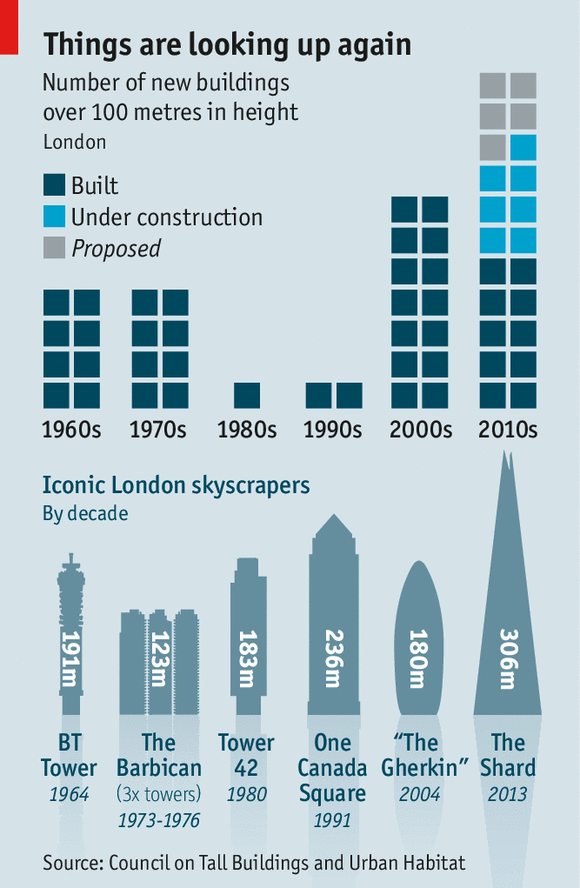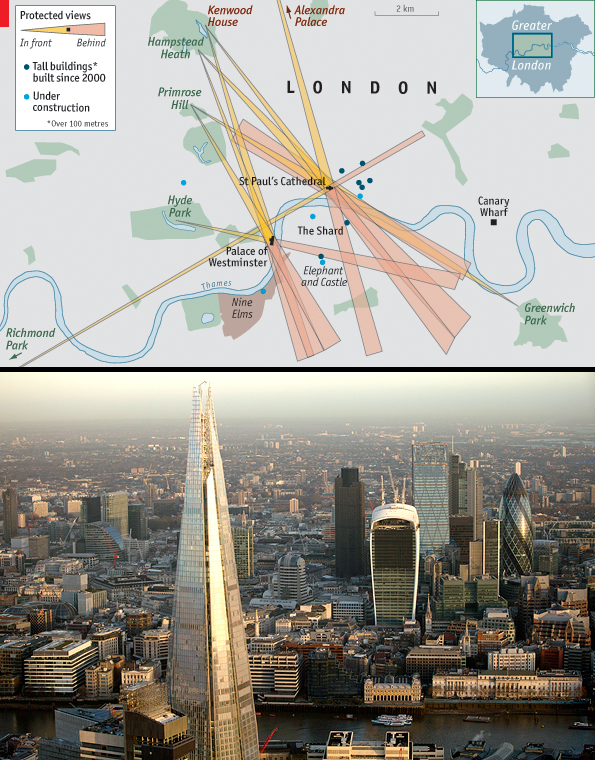Submitted by WA Contents
The ascent of the city
United Kingdom Architecture News - Feb 16, 2014 - 11:10 3976 views
The capital’s skyline is a growing mess. Let Boris sort it out

London is a long way down from the top of the Shard, 1,000ft above the city. But it does not feel quite so far down as it once did. Tall buildings are sprouting not just in the City and Canary Wharf, London’s two financial districts, but also in places that had never seen a skyscraper, such as around Battersea Power Station and Elephant and Castle. Of the 41 buildings in the city taller than 100m, 24 have been completed since 2000. Another seven are under construction, many more in the pipeline. In short order, the capital’s skyline is being transformed.
London has long been a low-rise city. For most of the 20th century Britain’s tallest commercial building was in Liverpool. In the 1960s planners embraced Corbusian high-rise brutalism—including the tower that houses The Economist. But, partly due to mistakes made then, tall buildings fell from favour for two decades (see chart).
Today’s boom is much bigger. It is stoked by soaring demand for office space from expanding businesses and even greater pressure for housing, driven by gentrification and population growth. A shortage of land in a city constrained by a tight green belt makes it profitable to build upwards. Foreign money—whether from Arab sovereign-wealth funds or wealthy Malaysian investors who buy flats before they are built—means there is plenty of finance for risky projects. And the authorities, for reasons both idealistic and pragmatic, are minded to allow construction.
In theory, the London Plan, laid out by the mayor’s office, determines the city’s shape. Tall buildings are encouraged in a few “opportunity areas”, especially if they are architecturally striking, explains Sir Edward Lister, the capital’s head of planning. The plan also protects views of St Paul’s Cathedral and the Palace of Westminster, as seen from London’s larger parks. You must, for example, be able to see both buildings from a specific oak tree on Hampstead Heath. Erecting tall buildings behind them is discouraged, too.

THE VIEWPOINTS OF LONDON
These protected views help to explain why tall buildings are rising in such a dispersed pattern. The Shard will not get neighbours anytime soon, as it is wedged between two viewing corridors. In the City, towers are scattered instead of crowding around transport hubs, as economic theory might predict. Their odd designs—described by nicknames such as the Gherkin, the Walkie Talkie and the Cheesegrater—are in some cases a means of avoiding imposing on St Paul’s. Only at Canary Wharf, which is too far east to spoil many views, do cuboid skyscrapers rub together in the way they do in other big cities.
The other reason London’s tall buildings are so oddly spread is local democracy. In the conservative borough of Westminster, the council resists almost all new tall buildings; despite soaring rents, no new skyscrapers have been built there since the 1960s. In the corporatist City, expensive architecture is prized. Almost anything goes in poor Labour-run authorities such as Lambeth, Southwark and Tower Hamlets.
In Elephant and Castle, part of Southwark, at least two towers are expected to join the Strata, an ugly 148m building that incorporates rarely-moving wind turbines. At Nine Elms, on the border between Lambeth and Wandsworth, another undistinguished tower will be joined by several more over the next few years. More still are going up at Stratford and Croydon. Councils—and the mayor’s office—smile on big development projects which spruce up neglected areas or raise money for infrastructure. The Nine Elms projects will help to pay for an Underground extension to Battersea. Towers in Elephant and Castle will provide new socially-rented housing.
Rising temperatures
The rapid, chaotic rising of London upsets some. Sir Simon Jenkins, head of the National Trust (and formerly with this newspaper), says that all new tall buildings should be stopped. Both English Heritage, a public conservationist body, and Westminster Council object to Lambeth council’s plans to allow new office blocks on the South Bank near Waterloo station—where, it is said, they will spoil the view of Parliament. Last November Westminster won a judicial review of Lambeth’s decision: an unhappy escalation of decades of inter-borough warfare over planning.
Oddly, businessmen are not much happier with the way things work. Thanks to the panoply of different authorities in London, getting planning permission is expensive and takes a long time, says Ian Simpson, an architect. A new tower he has designed near Blackfriars Bridge will have taken 14 years to plan and build when it is finished. Protected viewing corridors prevent many projects which would be useful. And the entire system adds enormously to the cost of construction. According to a study by Paul Cheshire and Gerard Dericks of the LSE, firms hire well-known architects as a way to ensure they win planning permission: a popular architect, on average, can get 19 storeys more. The buildings they design, while pretty, are often costly and impractical.
London needs a better, stronger plan. The mayor should provide it. A single authority could reduce the cost and uncertainty of the current system for developers. It would allow planning to be more clearly linked up with transport— ideally, projects such as Crossrail would lead to more construction near stations such as Tottenham Court Road. It might even help conservationists: since the mayor would be directly accountable, he might pause before allowing an ugly building. London’s skyline is changing faster than ever. It is time the system that regulates it changed too.
For more visuals,please visit the website
> via The Economist
